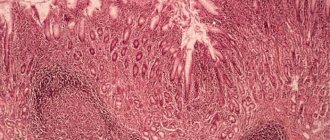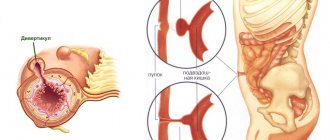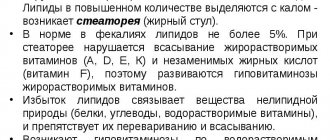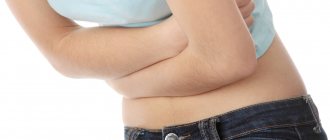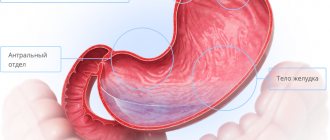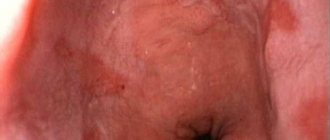Indications for use of the gastric lavage procedure
Gastric lavage - when to use this method:
- Food poisoning – a person has consumed stale food, after which he feels nausea, dizziness and abdominal pain;
- Excessive alcohol consumption - excess ethyl alcohol in the body leads to serious consequences, a person feels overwhelmed and weak;
- Drug intoxication - occurs when a person deliberately takes too much medication to die or when a child eats pills mistaking them for candy;
- Eating poisonous mushrooms is an extremely dangerous condition that can lead to death.
- Poisoning with chemicals , salicylates or methyl alcohol. It often occurs in young children who, due to their age, can drink acetone, detergent, or soap. Sometimes it was observed among drivers who use their mouths to pour gasoline into cans.
- Intestinal obstruction - the syndrome can occur with a chronic predisposition or when swallowing some physical body that can interfere with the usual evacuation of stool.
- Overeating – recently more and more cases of bulimia have been reported, when a person does not control how much he eats.
- Rotovirus , an infectious disease that causes diarrhea, vomiting and respiratory symptoms.
Hospital flushing methods
If a person has serious intoxication, then home methods will not help solve the problem. In such cases, the patient is hospitalized in a hospital. Hospitals have special equipment in the form of a probe, containers, couches and other devices.
Emergency doctors will also help correct this unfavorable condition. If you warn them in advance about poisoning, they will take special devices and solutions with them.
Every person should know about such a procedure as gastric lavage. This can come in handy at any time after drinking alcohol or low-quality products.
Techniques and methods of gastric lavage
There are two ways to rinse the stomach: by inducing a gag reflex or by using a tube. The first technique can be performed at home if the patient does not require urgent hospitalization.
The technique using a probe requires certain skills and knowledge, so it is already performed by nurses in the clinic.
Gastric lavage without using a tube (restaurant method)
This method involves gastric lavage without a tube, if, for example, the patient cannot swallow this medical instrument or if his condition is not severe.
What is needed to carry out this manipulation:
- drinking solutions about 10 liters (saline, potassium permanganate solution or soda solution);
- collection basin;
- an apron and gloves for the person performing the procedure.
Step-by-step instruction:
- Give the patient a position in which the head is tilted below the shoulders or put on the couch on its side. This is a very important point, because if the posture is incorrect, the contents of the stomach can block breathing.
- Place a container in front of the patient.
- Prepare for those who will perform gastric lavage - wear gloves and an apron. Do not neglect this advice, since vomit contains toxins.
- Allow the patient to drink 500 ml of the solution in stages; there is no need to try to drink all 10 liters at a time - this can only do harm.
- After each such intake of liquid, give the patient a waste basin.
- In case of inhibition of the gag reflex , you should press either a finger or a spoon on the tongue. It happens that even such a movement does not provoke vomiting, then you need to take medications that cause this reflex.
- to continue gastric lavage until clear vomit appears.
This gastric lavage does not make it possible to wash out all the contents, so if you feel worse after cleansing, it is better to go to an ambulance.
Also, you need to know that it is strictly forbidden to use the restaurant method of cleansing the stomach in case of poisoning with vinegar, detergents, strong acids, polishes, alkalis - you can cause a burn to the larynx.
Gastric lavage using a thick tube
In severe situations, it is necessary to rinse the stomach using a thick probe.
To do this you need to prepare:
- A probe, that is, a rubber hose 80 cm or 120 cm long, with a diameter of 10-13 mm. On one side there is a cut, and on the other there is a round edge with a hole;
- Liquid for washing up to 10 liters (again, either water with salt, or soda, or potassium permanganate). The temperature of the solution should be up to 25 degrees; if the temperature is higher, toxins can be absorbed into the walls of the stomach. Water that is too cold can trigger a spasm;
- Container with a funnel up to 1 liter;
- Towels or napkins;
- Basin;
- Protective clothing for the person performing the manipulation;
- Oil or Vaseline.
Such gastric lavage is extremely difficult to do independently for a person without medical education, since you need to have the skill to correctly insert the probe and correctly calculate the proportions of the solution for infusion.
Step-by-step instruction:
- Correctly calculate the volume of liquid infused - about 5 liters of solution are needed per 1 kg of weight. It is important not to exceed the required dose; if the amount of liquid administered is much higher than permissible, water poisoning may begin.
- Find the correct position for the patient - lying on his side (without a cushion under the neck) or sitting with his head down, but leaning on the back.
- Place an oilcloth or towel on your chest.
- Before you begin, you need to measure to what depth the probe will be inserted - to do this, measure the distance from the mouth to the ear, and then down along the abdominal wall to the edge of the xiphoid process. For precise insertion, it is better to mark the tube.
- Familiarize the patient with the possible feeling of nausea ; to suppress it, you need to breathe through your nose. Also, explain that pulling out the hose and biting it is extremely dangerous!
- Generously coat one end of the hose with emollient oil.
- Place one end of the tube in the mouth and gradually move it deeper; the patient must swallow at the same time. During the progress, carefully monitor the person’s condition; if he begins to choke or turn blue, it is necessary to urgently pull the probe out. There is a possibility of the probe getting into the larynx.
- In case of resistance , you can hold the tongue with your finger, ask for outside help to protect the patient’s hands and spray the throat with lidocaine.
- Understand that the hose has reached the stomach - or lower the probe below the body, the contents of the stomach will come out, or measure it with a Janet syringe.
- Attach the funnel to the tube and hold it level with your stomach. Gradually pour in 500 ml of solution and raise the funnel above the patient’s head, the liquid will begin to go into the probe, and as soon as the solution remains at a minimum, lower the funnel down - waste will begin to come out, the first part of which is usually sent for analysis. It is important not to wait for the solution to completely drain from the funnel into the probe; air may enter the stomach and then the process will be disrupted.
- Carry out gastric lavage until completely clear water comes out.
- Afterwards, you need to remove the funnel and carefully remove the probe.
Gastric lavage using a thin gastric tube (nasogastric)
Often used not only for gastric lavage, but also for diagnostic purposes. Such a medical instrument can be inserted through the mouth or nose.
What you need to have:
- gastric tube 5 mm;
- emollient, oil for example;
- solution for administration, 10 liters (listed above, choose one of them);
- Janet syringe;
- waste basin and towels;
- necessary clothing attributes for a nurse - an apron or gown, gloves.
Step-by-step instructions for administration through the nose:
- Warn the patient of possible discomfort.
- Sit and support the patient on the back, lower his head or lay him on his side.
- To track which nostril is more passable , to do this you need to breathe through them one by one.
- Measure the length of the insertion hose - from the nose to the ear and down along the body to the xiphoid process. Write a mark on the hose, on average 15-18 cm.
- Wear protective clothing and wash your hands, and cover the patient’s chest with oilcloth before the procedure.
- Treat one end of the tube with an emollient, stand on the right or in front, and gradually insert the tube into the nasal passage. Under no circumstances should force be used.
- Swallowing the patient speeds up the process. If the injection is successful, the person should breathe, swallow and speak calmly. You can offer him to drink water with a straw - this will make the process easier.
- To determine the moment of reaching the stomach, it is necessary to install the Janet syringe into the edge of the probe and pull it towards you - if the water from the stomach ends up in the syringe, then the required place has been reached. If there is nothing, move it another 5 cm.
- Fill the syringe with rinsing liquid (250 ml) and inject it into the tube. Next, take the mass back from the stomach and pour it into a basin. If there is blood, you should consult your doctor.
- Carry out this sequence of actions until clean water is collected.
- To complete the manipulation , remove the syringe from the tube and slowly remove it.
Features of gastric lavage in children
The course of action itself is completely identical to washing in adults.
The main thing is to choose the correct thickness of the probe and calculate the proportion of the injected washing solution. To choose the right volume, you need to study the following recommendations:
- Newborns - from 30 to 50 ml of liquid;
- From 1 to 6 months – 100 ml;
- From 6 to 12 months – 200 ml;
- Over a year old - calculate using the formula =200+100 ml x (number of years -1).
How to properly cleanse children? Often children do not understand the need for such a procedure and may actively resist, so it is worth resorting to help.
Like adults, there are two options for body position during the procedure - sitting or lying on your side.
If sitting, then the assistant sits the sick child on his lap, fixes his legs with his own, holds his torso and arms with one hand, and holds his head with the other.
If lying down, the child is wrapped in a diaper and placed on his side on the table. The helper also holds the torso and head.
Gastric lavage in childhood
Every mother should know how to cleanse her child's stomach at home. There are no special contraindications to washing. Children under seven years of age are recommended to be secured using swaddling.
Remember, if the child has lost consciousness, then performing washing procedures is strictly prohibited.
The temperature of the finished solution should be within 18-22 degrees.
The technique is as follows.
- First, the oral cavity is irrigated. This is necessary in order to cleanse the mucous membrane of remnants of vomit and contaminants.
- Do not insert a probe into a child who is twitching or crying. This will only make things worse.
- Don't forget to lubricate the tip with Vaseline or glycerin.
- Insert a spatula between the teeth. This will help widen your mouth and make inserting the tube easier.
- To determine the required amount of solution, find out the child’s weight and calculate according to the diagram. There are 5-7 milliliters of liquid per 1 kilogram. That is, a child weighing 20 kilograms can be administered 1 liter of medicinal solution.
Doctors also highlight several features.
- Gastric lavage in infants under 4 months should be performed through the nasal cavity using a catheter.
- If a child has swallowed some dangerous liquid, the body must be rinsed within one to three hours. In this case, only probe rinsing is used.
- If blood is observed in the vomit, this should not be considered a contraindication to the procedure.
- There is no point in neutralizing acid with a crevice. This process will only worsen the patient’s condition due to the formation of carbon dioxide.
If toxic components enter the rectum, then another method is used using an enema.
How to rinse your stomach yourself at home?
Washing the stomach at home using a tube without qualified assistance is extremely difficult, so the method of inducing vomiting is used.
If a patient experiences abdominal discomfort , dizziness, nausea and pain, he should drink the maximum amount of prepared liquid at one time (on average 6-7 glasses) - boiled water, saline solution, potassium permanganate solution or water with sorbents.
Immediately after consumption, press on the tip of the tongue, vomiting is guaranteed. Do this until completely clean water appears in the waste container.
Features of gastric lavage in case of poisoning with acids and alkalis
Ingestion of such substances is very dangerous and sometimes fatal, so it is important to take the necessary measures quickly. Alkalis and acids are conventionally classified as scalding substances, that is, when they come into contact with human mucous membranes, they burn and destroy tissue.
Gastric lavage for acid poisoning
Acid poisoning leads to irreversible changes in the mucous membranes of the mouth, larynx, and stomach. If you consume this type of acid, an extremely serious life-threatening condition occurs.
There may be bloody vomiting, agony, painful shock, sharp pain in the abdomen and chest. In this case, it is necessary to apply the method of gastric lavage through a thick probe with the addition of burnt magnesia or lime water. For acute pain in the abdominal area, use a heating pad with ice.
Types of acids:
- Inorganic - nitrogen, sulfur, hydrochloric.
- Organic - oxalic and vinegar.
Gastric lavage for alkali poisoning
Today alkalis are actively used in many industries - textile, chemical, medical, industrial, and even at home we are constantly in contact with them.
The most famous are ammonia, caustic soda, liquid glass, slaked and quicklime, sodium hydroxide, potassium hydroxide. Contained in everyday life in detergents, bleaches, and cleaning products.
It is worth noting that the entry of alkalis into the human body is more dangerous than the entry of acids. A special feature of alkalis is the ability to break down protein; when poison gets inside, it burns everything in its path.
Starting from the digestive organs and ending with the kidneys, liver, heart. This intoxication provokes instant reactions in the human body - vomiting and diarrhea with blood, stagnation of urine, spasms in the larynx.
It is important to know that with this type of poisoning it is better to immediately call an ambulance rather than experiment at home. There are conditions with alkali poisoning when it is strictly forbidden to do gastric lavage yourself.
The only thing that experts agree on is that before the arrival of medical personnel, you can drink enveloping agents - milk, butter or water.
Gastric lavage solutions
The following solutions can be used to lavage the stomach:
- A solution of manganese has antiseptic and antimicrobial properties and is often used for rinsing. Throw a few crystals into prepared boiled water. It is important to strain the resulting liquid through gauze before use so that the remaining crystals do not enter the stomach.
- The saline solution is prepared as follows: add 1 tablespoon of salt to 1 liter of boiled water. Actively cleanses not only the stomach, but also the patient’s blood of toxins.
- Soda solution , you need to mix 2 tablespoons of soda and 5 liters of prepared water. Contraindicated for use in case of acid poisoning.
- The use of pharmaceutical sorbents is recommended to ensure that gastric lavage is most successful. They contain all the necessary components to neutralize the effects of poisons and detailed dilution instructions.
Possible difficulties and complications when washing the stomach with a tube
Gastric lavage with a tube is extremely important to perform either in the hospital or by a healthcare worker at home. This method has several difficulties in application: correct insertion of the probe and clear calculation of the volume of water for administration.
If the above points are not taken into account, this may negatively affect the patient’s health:
- If a large amount of solution is administered, there is a risk of water poisoning;
- If done incorrectly, the hose may bend or even damage the walls of the stomach.
Gastric lavage at home
Incorrect gastric lavage with water can only worsen the general condition of the body. Doctors identify several mistakes that patients make at home.
- If you take a large amount of water at one time, this will lead to the opening of the gastric sphincter and the release of toxic substances into the intestinal tract. The portion is calculated based on the patient’s body weight. That is, there are 5-7 milliliters of liquid per kilogram.
- Adverse complications occur when the volume and concentration of the solution are not maintained. There is an excess, deficiency, excess concentration, weakness of the solution.
- If a probe or siphon is inserted carelessly, the walls of the esophagus are torn.
The gastric lavage algorithm is based on the following steps:
- All manipulations must be carried out in a supine position.
- The approximate serving size reaches two liters.
- Prepare a container for vomit.
- Take the medicine only when warm. The time interval between doses should be short.
- After taking the liquid, the person puts his feet together and presses his stomach with his hands. The torso must be tilted slightly forward.
- To create a gag reflex, you need to press your tongue with your fingers or a spatula.
- To remove the sour taste in the mouth, take 500 milliliters of soda solution. After taking the medicine, the urge to vomit will begin again.
To complete the manipulations, take Levomycetin in the amount of one tablet.


